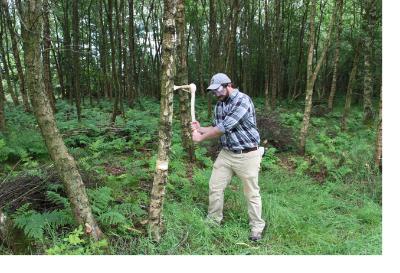BATWEP
Bronze Age Tree-felling and Woodworking Experimental Project
 The aim of the project is to test if changes in the shape and hafting styles of Bronze Age axes from early through to late 2nd millennium BC are motivated by increased efficiency. To test this hypothesis, replicas of an Early Bronze Age flat axe, a Middle Bronze Age palstave and a Late Bronze Age socketed axe (the latter with two different hafts) have been cast and hafted by traditional bronze-smith Neil Burridge (Bronze Age Craft). The axes were used in a series of controlled field tests involving the felling and sectioning of birch trees from Wallington, a National Trust site in Northumberland. Energy expenditure was also calculated by monitoring heart rate during the tests, and the wear traces generated on the axes were recorded and analysed with a stereomicroscope.
The aim of the project is to test if changes in the shape and hafting styles of Bronze Age axes from early through to late 2nd millennium BC are motivated by increased efficiency. To test this hypothesis, replicas of an Early Bronze Age flat axe, a Middle Bronze Age palstave and a Late Bronze Age socketed axe (the latter with two different hafts) have been cast and hafted by traditional bronze-smith Neil Burridge (Bronze Age Craft). The axes were used in a series of controlled field tests involving the felling and sectioning of birch trees from Wallington, a National Trust site in Northumberland. Energy expenditure was also calculated by monitoring heart rate during the tests, and the wear traces generated on the axes were recorded and analysed with a stereomicroscope.
As the field tests were deemed inconclusive, further efficiency tests were planned, in which the axes were mounted on purpose-built rigs and tested in laboratory conditions. The rig tests are due to be completed in 2017.
Project leader: Andrea Dolfini
Other project team: Tom Joyce, School of Mechanical and Systems Engineering, Newcastle University; Les Ansley, Department of Sport and Exercise Sciences, Northumbria University; Lindsay Allason-Jones OBE, School of History, Classics and Archaeology, Newcastle University.
Contact: Andrea Dolfini
Sponsors: School of History, Classics and Archaeology, Newcastle University; The Great North Museum: Hancock
Partners: Great North Museum : Hancock; Neil Burridge, Bronze Age Craft; The National Trust Wallington
Project dates: 2014-2017
Project blog: Read the field tests blog written by Newcastle alumnus Joshua Desrosier: https://batwep.wordpress.com/
